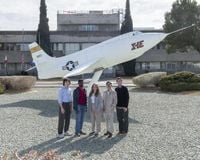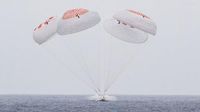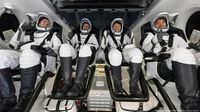After nearly five months orbiting more than 250 miles above the Earth, NASA’s Crew-10 astronauts have safely returned home, marking a historic Pacific Ocean splashdown and closing another chapter in the ongoing story of human spaceflight. On August 9, 2025, at precisely 11:33 a.m. Eastern Daylight Time (3:33 p.m. UTC), the SpaceX Crew Dragon capsule, Endurance, drifted gently into the Pacific waters off the coast of California, its four orange-and-white parachutes billowing above. This was a first for NASA’s Commercial Crew Program, which until now had favored Florida’s Atlantic coast for its ocean landings.
The four-person crew—NASA astronauts Anne McClain (mission commander) and Nichole Ayers (pilot), JAXA’s Takuya Onishi, and Roscosmos’ Kirill Peskov—had launched from Earth on March 14, 2025, and arrived at the International Space Station (ISS) two days later. Their return journey began the previous day, August 8, when Endurance undocked from the ISS at 6:15 p.m. Eastern, embarking on an 18-hour homeward trip that would see them endure re-entry temperatures of around 3,000 degrees Fahrenheit. As the capsule bobbed in the Pacific, McClain radioed, “From the entire Crew-10, thank you. It was truly the ride of a lifetime,” according to NASA’s live broadcast and reporting by BBC and Space.com.
Crew-10’s mission was far from a simple ferry ride. Over 146 days in orbit, the astronauts conducted more than 200 “important and time-sensitive research” experiments, as described by NASA. Their work ranged from studies on plant growth and cell behavior in microgravity to new insights into how blood flows from the brain to the heart in the absence of gravity—a crucial factor for the health of future long-duration space travelers. The team also investigated the physiological and psychological changes that astronauts endure on missions stretching from weeks to a full year. According to NASA’s official blog, these experiments are vital for preparing humans for exploration beyond low-Earth orbit, whether that’s returning to the Moon or one day venturing to Mars.
“We got to accomplish a lot of really amazing operational things. We got to see some amazing views, and we have had some really big belly laughs and a wonderful time together,” said Ayers in a farewell ceremony before departure, as reported by NPR and Space.com. It was the first trip to space for both Ayers and Peskov, while McClain and Onishi each marked their second journey to the ISS. Onishi, notably, served as commander of the ISS’s Expedition 73 from April until August 5, 2025, before handing over command to Russian cosmonaut Sergey Ryzhikov.
The crew’s return wraps up NASA’s tenth commercial crew rotation, a testament to the agency’s evolving partnerships with private industry. SpaceX has been ferrying astronauts to and from the ISS since 2020, following the retirement of the Space Shuttle program in 2011. This collaboration, part of NASA’s Commercial Crew Program, has not only restored America’s ability to launch astronauts from its own soil but has also diversified the pool of partners and landing sites. According to Space.com, the shift to West Coast splashdowns—including this mission—was made to minimize the risk that falling space debris could damage property or injure people, a practical adjustment in the ever-changing landscape of space operations.
The Crew-10 astronauts’ work built directly on the legacy—and, in some ways, the challenges—of previous missions. They replaced Crew-9, whose members, Barry "Butch" Wilmore and Sunita "Suni" Williams, found themselves stranded for nine months aboard the ISS after their Boeing Starliner capsule developed propulsion issues. Their eventual rescue by a SpaceX capsule underscored both the risks and the resilience of international spaceflight. Wilmore, a 25-year NASA veteran, retired this week, closing out a remarkable chapter in the agency’s history, according to BBC.
As Crew-10 prepared for their journey home, their replacements were already settling in. Crew-11—comprising NASA’s Zena Cardman and Mike Fincke, JAXA’s Kimiya Yui, and Roscosmos’ Oleg Platonov—arrived at the ISS on August 2, 2025. The outgoing astronauts spent several days advising their replacements, passing on the practical wisdom and operational know-how that only comes from months in microgravity. Crew-11 is now slated for a six-month mission, continuing the cycle of research and maintenance that has defined the ISS since its first crew arrived in 2000.
The sense of accomplishment—and perhaps a touch of melancholy—was palpable among Crew-10 as they reflected on their time in orbit. “All of us are keenly aware that we may never get to do this again,” McClain shared before departure, as quoted by NPR. “We’ve been very pensive over the last days of understanding what we have all got to be a part of.” The astronauts’ gratitude was echoed in their actions, as they took time to savor the views, the camaraderie, and the unique perspective that only space can offer. Ayers summed up the sentiment: “I think that [we’re] leaving with a heart full of gratitude, and [we’re] excited to see where the International Space Station goes after we get home.”
This mission also highlighted the truly international nature of modern spaceflight. With astronauts from the United States, Japan, and Russia working side by side, Crew-10 embodied the spirit of cooperation that has kept the ISS running for a quarter-century. As NASA and its partners look ahead to retiring the ISS around the end of the decade, the hope is that commercial companies will step in to launch new stations, ensuring that humans continue to have a foothold in low-Earth orbit—and perhaps beyond.
NASA’s decision to broadcast the splashdown live, starting at 10:15 a.m. Eastern on August 9, 2025, allowed viewers around the world to witness the return. The agency also held a teleconference after the astronauts were safely retrieved, underscoring the transparency and public engagement that have become hallmarks of the space program.
With the successful conclusion of Crew-10’s mission, NASA, SpaceX, and their international partners have once again demonstrated the power of collaboration, innovation, and sheer human determination. The lessons learned from these five months in orbit will ripple outward, informing not just the next crew, but the future of exploration itself.



